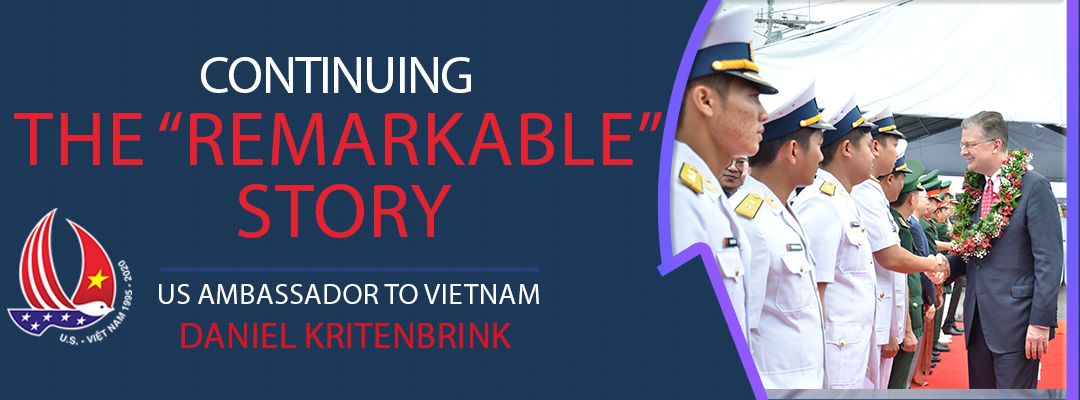 |
| 2020 is an important milestone, marking the 25th year since Vietnam and the United States of American officially established diplomatic relations. On such occasion, the United States Ambassador to Vietnam Daniel Kritenbrink has briefly talked about many milestones in the bilateral relations, from President Bill Clinton’s official announcement of formal normalization of diplomatic relations between the United States and Vietnam, the first official visit of the late Prime Minister Phan Van Khai, the meeting in the White House between General Secretary of Vietnam Communist Party Nguyen Phu Trong and President Barack Obama to the recent visits of President Trump to Vietnam, as well as the arrival of USS THEODORE ROOSEVELT aircraft carriers in Da Nang on March 9th. According to the Ambassador, these clear evidences showed “remarkable” developments of the U.S.-Vietnam relations, demonstrated both sides’ deep commitments in many sectors to promote the Comprehensive partnership and explore enormous potentials for cooperation in bilateral relations. |
A “REMARKABLE” STORY |
| In his message on the 25th Anniversary of the United States – Vietnam relations, Secretary of State Mike Pompeo has hailed the establishment of diplomatic relations between the two countries as “a historic step,” as both sides “overcome the past and look toward the future.” Therefore, could you share your perception of the past developments of the United States – Vietnam relations since this “historic step?” Looking at all we have achieved together, the progress of the U.S.-Vietnam bilateral relationship over the past 25 years has been no less than extraordinary. In 1995, when President Bill Clinton announced the normalization of U.S. diplomatic relations with Vietnam, our two countries had nearly no trade and very limited people-to-people connections. Today, our nations are trusted partners with a friendship grounded in mutual respect, who cooperate in an amazing number of areas, from trade and security to health and the environment. Over the past 25 years, our countries have celebrated a number of remarkable milestones. Our two embassies in Washington and Ha Noi opened in 1995, and just two years later, the U.S. Senate confirmed Douglas “Pete” Peterson as the first U.S. Ambassador to the Socialist Republic of Vietnam. Ambassador Peterson, who served as a U.S. Air Force pilot during the war in Vietnam and spent over six years as a prisoner of war, devoted his tenure to reconciliation and building a lasting relationship between Vietnam and the United States. In November 2000, President Clinton became the first U.S. president to visit Vietnam in over 30 years. Even though, at that time, there were many different views in both the United States and Vietnam about this visit, and many people were skeptical that the two countries could move forward from our tragic history, it is clear that President Clinton successfully fostered goodwill during his trip to Vietnam. If you look at the size of the friendly crowds in the photos during President Clinton’s visit to Vietnam, it’s easy to see that there was a sense of excitement for this growing partnership between the United States and Vietnam. |
 |
| As the first Prime Minister of Vietnam to visit the United States, Phan Van Khai’s historic 2005 meeting with U.S. President George W. Bush further helped our two nations overcome our painful past and realize the unlimited possibilities of our bright future together. Prime Minister Phan Van Khai’s contributions to the U.S.-Vietnam partnership continue to have a lasting effect on our rapidly growing cooperation in trade, regional security, and people-to-people ties. A humble but persistent reformer, his work will influence Vietnam for generations to come. Another important milestone in our bilateral relationship that I remember quite well was the first visit of General Secretary Nguyen Phu Trong to the Oval Office to meet with President Barack Obama in July 2015. At the time, I was serving on the National Security Council and had the honor both of joining the meeting and of working on the joint statement for this visit. I have to say, negotiating a joint statement with our Vietnamese partners has always been an enjoyable and meaningful exercise, one in which we are always able to advance and strengthen our partnership. That visit also marked the 20th Anniversary of U.S.-Vietnam diplomatic relations. There was genuine warmth between the two leaders and a broad strategic vision for deepening cooperation for a long-term partnership. |
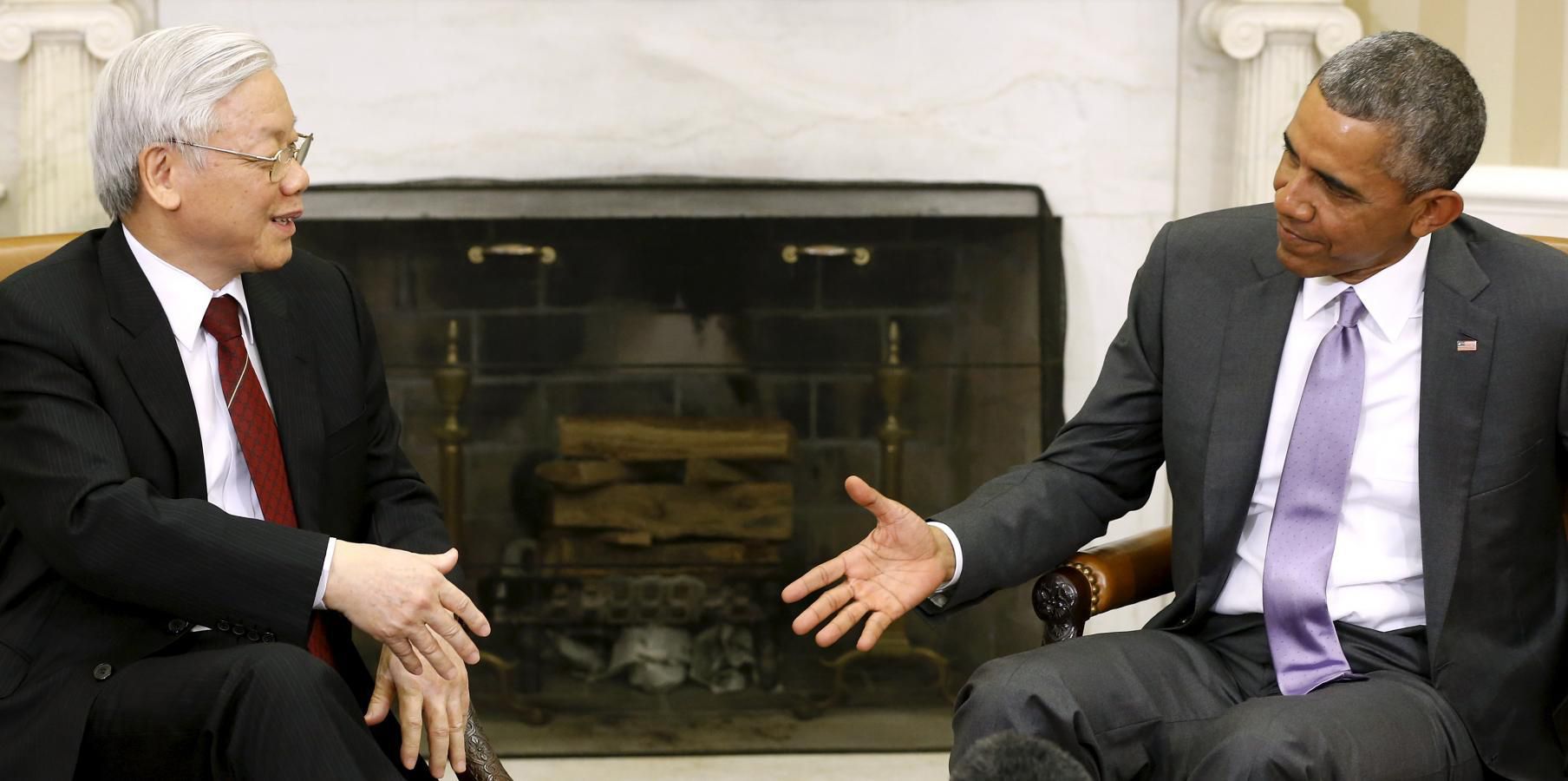 |
| General Secretary of the Vietnam Communist Party Nguyen Phu Trong and U.S. President Barack Obama in the White House during the former’s visit to the U.S. on July 2015. (Photo: Reuters) |
| I was honored to be in Vietnam as Ambassador during President Trump’s incredibly productive visit to Danang and Ha Noi in November 2017. First, the President attended the 25th Annual Asia-Pacific Economic Cooperation (APEC) Economic Leaders’ Meeting and 2017 APEC CEO Summit in Danang; Second, President Trump and President Tran Dai Quang issued a joint statement during President Trump’s state visit to Ha Noi outlining steps the two sides would take to expand the Comprehensive Partnership between our two countries. During the 25th Annual Asia-Pacific Economic Cooperation (APEC) Economic Leaders’ Meeting and 2017 APEC CEO Summit in Danang, President Trump delivered a clear message that the United States seeks robust trade relationships rooted in the principles of fairness and reciprocity. In outlining his vision for a free and open Indo-Pacific, the President emphasized that it is in America’s interest to have partners throughout the region that are thriving, prosperous, and self-reliant. The Joint Statement issued by President Donald Trump and President Tran Dai Quang in November 2017 reaffirmed their commitment to deepening ties on the basis of previous joint statements between the two sides; respect for the United Nations Charter and international law; and each other’s independence, sovereignty, territorial integrity, and respective political systems. The Joint Statement also specifically addressed a broad number of important areas of cooperation between our two countries. Of course, I also cannot forget the Ha Noi Summit in February 2019. Of all the countries in the world that could have hosted the second summit between President Trump and North Korea's Chairman Kim Jong Un in February 2019, we asked our Vietnamese friends to host. We did that because Vietnam is a trusted partner, Vietnam has demonstrated its ability and commitment to strictly enforcing United Nations Security Council resolutions related to North Korea, and Vietnam is also a successful country that turned from a centrally managed economy into one that is unleashing free market forces and conducting economic reform to the benefit of its people. During the visit, President Trump became the first U.S. President to visit Vietnam twice. In addition to engaging his North Korean counterpart, President Trump has successful meetings with General Secretary and President Nguyen Phu Trong and Prime Minister Nguyen Xuan Phuc that further strengthened our Comprehensive Partnership. |
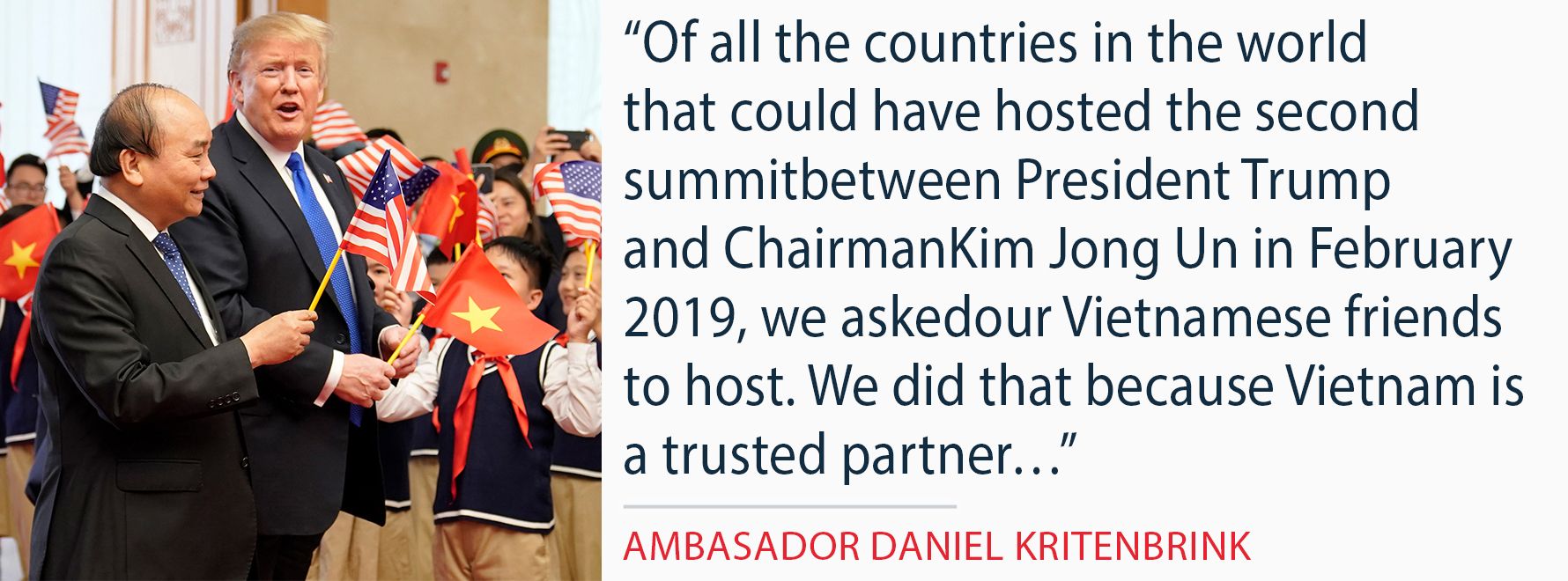 |
| These remarkable milestones demonstrate just how much the United States and Vietnam have achieved together. As we mark the 25th anniversary of our bilateral relations this year, it is clear that our two nations have much to celebrate. It is also clear that building this relationship wasn't easy and didn't just happen by chance. It was the result of courage, determination, and vision of many people of goodwill on both sides who believed in the possibility of peace. They were firmly committed to the belief that the United States and Vietnam could work together in learning from and putting aside the past, even as we continue to honor it. I am very optimistic about our shared future and can’t wait to see what we achieve in the next 25 years. |
FIVE PRIORITIES |
| In 2017, you stated five priorities during your term as the Ambassador of the United States to Vietnam. As you are in your third year, how would you evaluate the progress of such goals? The United States and Vietnam share a number of common interests, and we collaborate closely every day to advance those shared goals. This is clearly demonstrated by the breadth and depth of cooperation between our two great countries. In areas as diverse as trade, development, education, health care, energy, and security, the United States and a strong, prosperous, and independent Vietnam are working together with a shared commitment to peace and prosperity. In my Senate confirmation hearing, I set out five priorities for our bilateral partnership – five areas of shared, vital interest to both the United States and Vietnam. We have indeed made significant progress in all five areas. Security: We want to help Vietnam build its capacity to become an active and responsible contributor to regional and global security. The United States and Vietnam share vital security interests, including upholding international law, exercising freedom of navigation and overflight, and resisting coercion in the East Sea. Over the last two years, the U.S. Coast Guard delivered 18 patrol boats and a 3000-tonne, 115-meter cutter to the Vietnamese Coast Guard, with U.S. Coast Guard personnel joining the Vietnamese crew for the sail home. During his November 2019 visit to Ha Noi, Defense Secretary Mark Esper agreed to expand this program by transferring a second Coast Guard cutter in 2020. Also last year, two Vietnamese pilots trained alongside American officers in the U.S. Air Force Aviation Leadership Program. And, last summer, members of the U.S. military, working with their Vietnamese counterparts, delivered humanitarian assistance and hosted cultural exchanges as part of Pacific Partnership 2019 in the south-central province of Phu Yen. We look forward to repeating this event in 2020. Our cooperation continues to grow in other important areas, including peacekeeping, de-mining, humanitarian assistance and disaster response, law enforcement, and criminal justice system reform. |
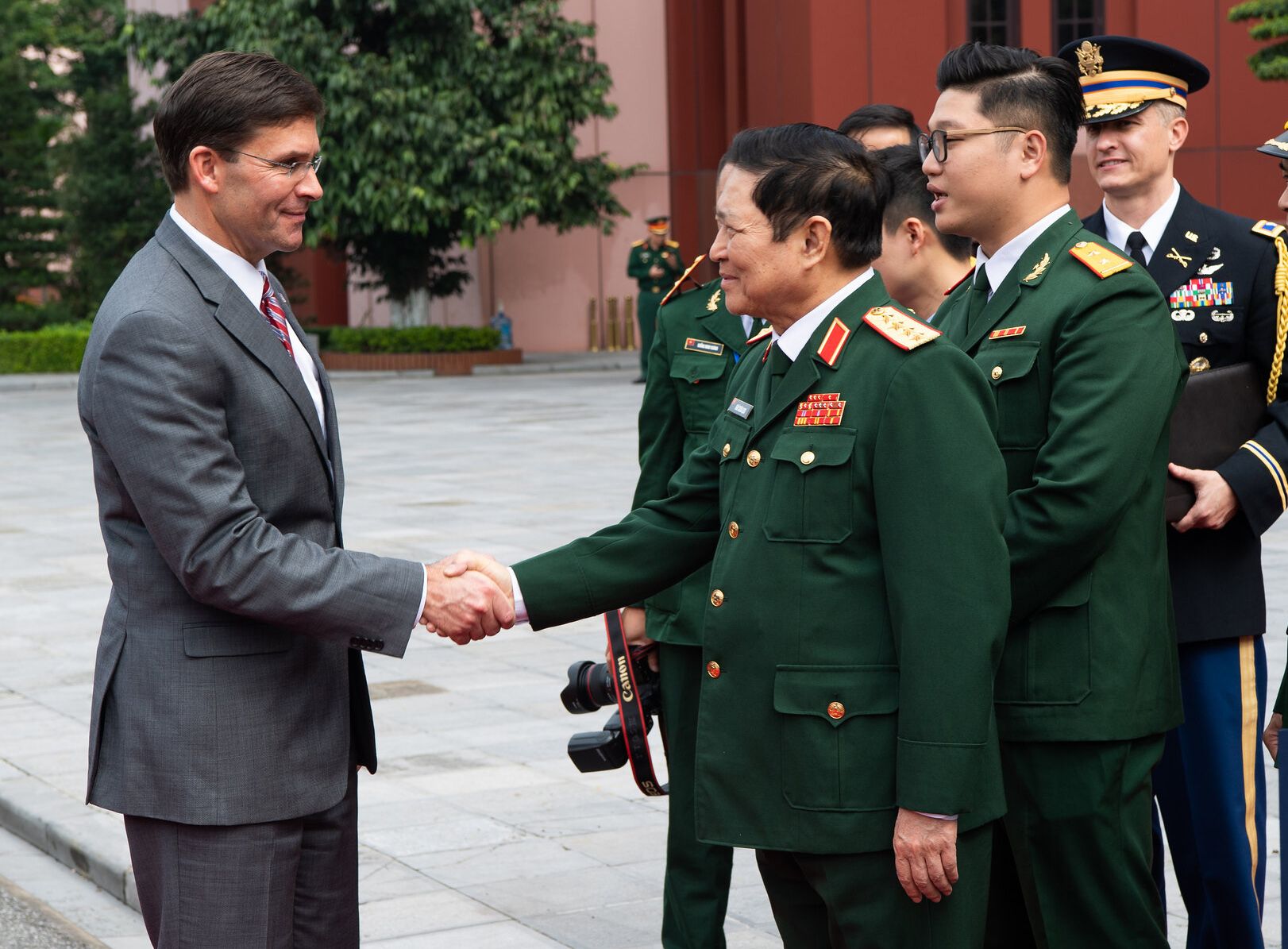 |
| U.S. Minister of Defense Mark Esper and his Vietnamese counterpart Ngo Xuan Lich during the former’s visit to Vietnam on November 21st, 2019. (Photo: Minh Quan) |
| In March 2018, we celebrated the first visit by a U.S. aircraft carrier since the end of the war with a historic five-day visit of the USS CARL VINSON to Danang for professional exchanges, community relations activities, and media events. In commemoration of our 25th anniversary, we just concluded another successful visit of the USS THEODORE ROOSEVELT Carrier Strike Group to Danang on March 9. We look forward to continuing these enriching defense exchanges with Vietnam in the future. We welcome our increasingly strong security cooperation ties with Vietnam, as was evident when Vietnam hosted the 2019 Ha Noi Summit between President Trump and Chairman Kim. We continue to work together to ensure a region safe from North Korea’s nuclear and missile programs, including by strictly enforcing UN Security Council Resolutions. Trade and Investment: Twenty-five years ago, our two countries had almost zero trade; today, we share over 77 billion dollars in bilateral trade—though the United States continues to run a substantial and growing trade deficit with Vietnam. We are committed to achieving free, fair, and reciprocal trade and investment with Vietnam by reducing barriers to American companies. Fortunately, Vietnam is also one of our fastest-growing export markets. More world-class U.S. companies are working with Vietnamese companies and investing in Vietnam. Our future is linked. Vietnam’s success is our success. Vietnam’s prosperity is our prosperity. |
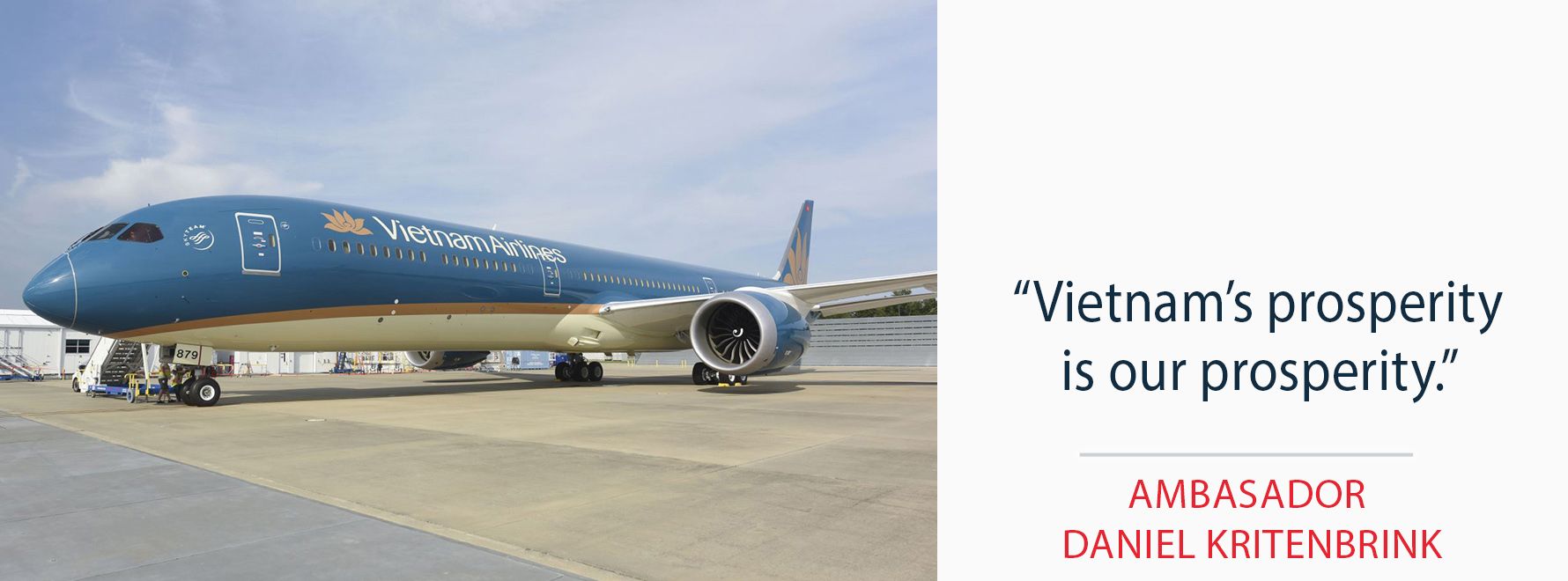 |
| Contracts of acquiring Boeing aircraft are among achievements between Vietnam – U.S. |
| Human Rights: The United States firmly believes that all nations are able to reach their full potential when the human rights of their citizens are protected. Progress on human rights remains a key priority for the United States and is an issue I follow closely and care about deeply. We regularly engage the Government of Vietnam on issues related to human rights, including during the U.S.-Vietnam Human Rights Dialogue. We also raise these issues with the Government of Vietnam at all levels, including in my meetings with Vietnam’s top leaders. People to People Ties: Investing in our future partnership means providing opportunities for our youth to start building lasting ties of friendship. Right now, nearly 30,000 young Vietnamese are studying in the United States, and each of them will return home with a world-class education and will contribute to a thriving economy. We have expert English teachers as well as English Teaching Assistants working throughout the country to help Vietnam reach its goal to be a country with strong English proficiency by 2025. Our Fulbright program supports people-to-people ties between hundreds of U.S. and Vietnamese universities so that the greatest minds in our two countries are working together on a daily basis. I urge American students to seek educational exchanges to Vietnam and Vietnamese students to look for educational and exchange opportunities in the United States. This year, Vietnam’s first independent, not-for-profit university, aptly named Fulbright University Vietnam, broke ground on its permanent campus, celebrated the graduation of its first cohort of Masters in Public Policy students, gained U.S. accreditation for this program, and welcomed 113 incoming freshman students to the inaugural year of its undergraduate program. |
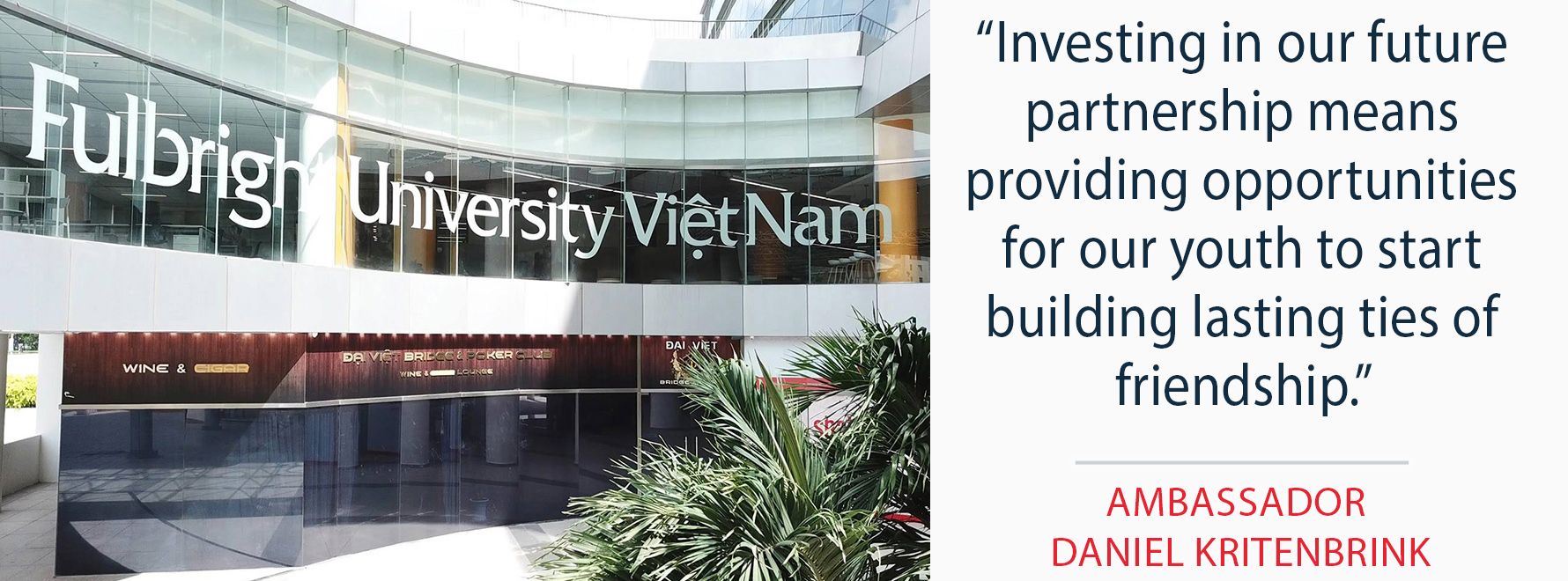 |
| The Fulbright program is a highlight in cooperation in the education sector between Vietnam and the U.S. (Photo: Fulbright University Vietnam) |
| Humanitarian and war legacy issues: On humanitarian and war legacy issues, we have made great strides. Although our partnership remains focused on the future, we know we also have a responsibility to address issues from our past. We continue our close cooperation with Vietnam to account for our missing personnel, clean up dioxin from Agent Orange, remove landmines and unexploded bombs, and assist Vietnamese people with disabilities. In 2018, USAID successfully completed a US$110 million dioxin remediation project at Danang Airport, and in April 2019, the United States and Vietnam launched the Dioxin Remediation at Bien Hoa Airbase Area Project, the final major dioxin hotspot in Vietnam. In December 2019, the United States also signed an agreement with the Ministry of National Defense to provide US$65 million towards implementing activities that provide direct services to persons with severe disabilities in eight priority provinces over the next five years. Specifically, we plan to work with the Government of Vietnam to strengthen Vietnam’s rehabilitation system, provide direct services to persons with severe disabilities including children, and develop community-based social services to improve the quality of life for persons with disabilities. |
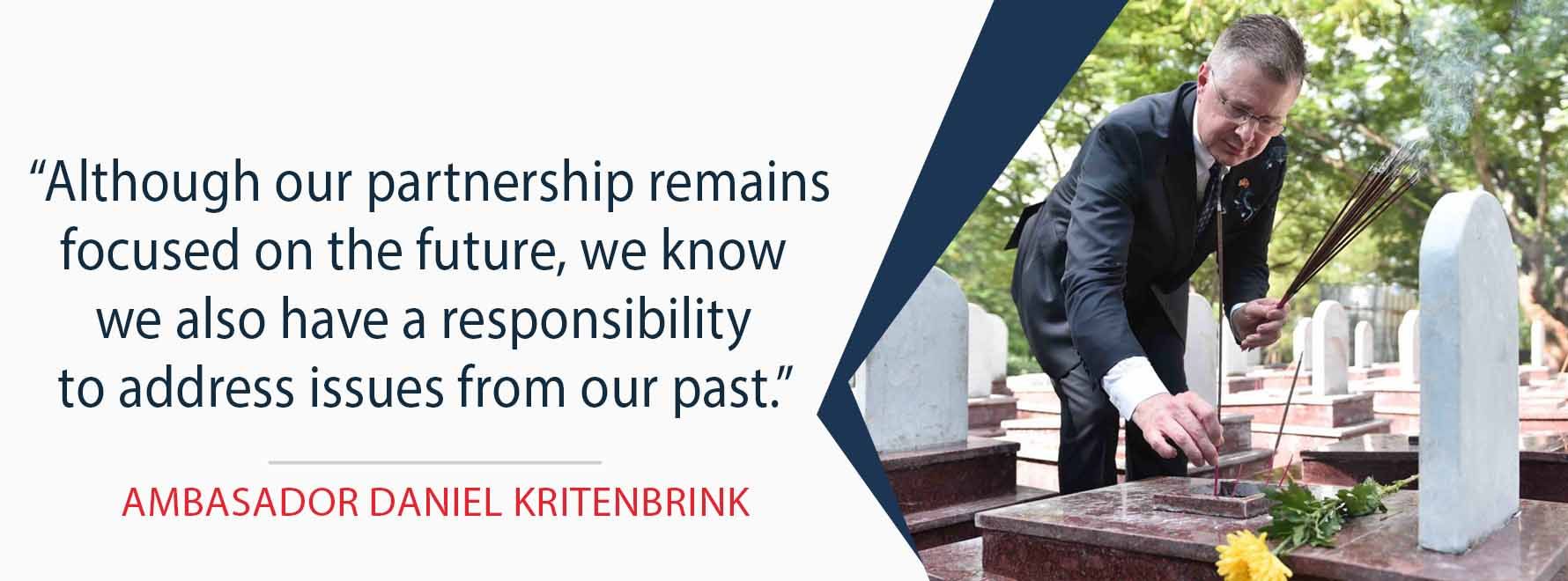 |
| U.S. Ambassador Daniel Kritenbrink offered incenses in respect of Vietnamese martyrs during his working visit to Quang Tri province on August 27th, 2019. |
| FOR THE FUTURE |
| On March 5th, the USS THEODORE ROOSEVELT aircraft carrier and the USS BUNKER HILL arrived in Danang, marking the 2nd time U.S. aircraft carriers have arrived in Vietnam after the War. In the press release, you mentioned how the visit came at a time when “our relationship is the strongest it has ever been.” Could you share your vision of the future bilateral comprehensive partnership? The recent five-day port visit of the USS THEODORE ROOSEVELT (CVN 71) and USS BUNKER HILL (CG 52) commemorated 25 years of U.S.-Vietnam diplomatic relations and followed the historic 2018 visit of USS CARL VINSON (CVN 70). This visit demonstrated the U.S.'s strong commitment to its comprehensive partnership with Vietnam and to a free and open Indo-Pacific. This partnership maintains a shared goal of regional peace, grounded in respect for international law, and committed to supporting Vietnam's lawful right to explore resources within its own territory. As I highlighted during the Carrier visit last week, the U.S. - Vietnam relationship is the strongest it has ever been. And with this strong momentum, we see a bright future ahead. The United States and Vietnam’s future together is very bright. And, it’s bright because of the tremendous potential for ever greater collaboration. Every day we see a growing bilateral relationship – more business deals, more tourists traveling to each other’s countries, more students on educational exchange programs, and increased security cooperation. |
 |
| U.S. sailors took pictures and exchanged culturally with Vietnamese youth during the visits of USS THEODORE ROOSEVELT aircraft carriers and USS BUNKER HILL cruisers to Da Nang from March 9th to 11th. (Photo: The U.S. Consulate General in Ho Chi Minh City) |
| Every day, American and Vietnamese business leaders develop strong trade ties enabling their commercial partnerships to prosper. We have gone from almost no trade 25 years ago to over US$77 billion in two-way trade today. Major U.S. firms have invested both in Vietnam’s manufacturing sector and in its infrastructure, and we expect their investment in energy and other infrastructure to continue and even accelerate under our Indo-Pacific Economic Vision. Together, entrepreneurs from our two countries continue to innovate and thrive. I believe our collaborative work to ensure the free and fair flow of goods and investment between our two countries will result in mutual prosperity. And we are committed not just to economic growth, but to sustainable development. To accomplish this, we partner with Vietnam to protect and preserve its natural resources – together we are investing in sustainable forestry management; combating illegal, unreported, and unregulated fishing and illegal wildlife trafficking; and improving air and water quality. Investing in our future partnership means providing opportunities for our youth to start building lasting ties of friendship. As I mentioned, right now, nearly 30,000 young Vietnamese are studying in the United States, and under the Fulbright Program, the U.S. Embassy sponsors 19 young Americans to teach English in communities throughout Vietnam. Educational exchanges can be one of the most fulfilling ways to develop cross-cultural understanding and friendships because of the ties built with classmates, professors, and host families. This year we celebrate 25 years of the establishment of diplomatic relations, but I’m looking forward to celebrating the next century of relations and seeing all the achievements of our partnership then. This year is an opportunity for us to renew our commitment to work together to ensure a bright future full of peace and prosperity for the American and Vietnamese people. Our future is linked. Your success is our success. Your prosperity is our prosperity. We know trusted partners prosper together. |
 |
| Permanent Deputy Minister of Ministry of Foreign Affairs of Vietnam Bui Thanh Son and Assistant Secretary of State for the Bureau of East Asian and Pacific Affairs David Stilwell, along with honorable guests, celebrating the symbolic icon to commemorate the 25th years of U.S. – Vietnam relations (1995 – 2020). (Photo: Nguyen Hong) |
| OVERCOMING CHALLENGES |
| Vietnam is fulfilling its responsibilities as a non-permanent member of the United Nations Security Council during 2020 – 2021, as well as holding the ASEAN Chairmanship in 2020. As the permanent member of the United Nations Security Council and an increasingly important partner of ASEAN, how would the United States strengthen its cooperation with Vietnam on the international stage? We are eager to support Vietnam in both its regional and global diplomatic roles this year, from joining the United Nations Security Council for a two-year non-permanent term to chairing ASEAN during a pivotal time in the organization’s history. For decades, American diplomacy with ASEAN has been consistently guided by our desire for a partnership of respect regarding the sovereignty of each of our nations, and a shared commitment to the fundamental rules of law, human rights, and sustainable economic growth. ASEAN demonstrated its commitment to many of our shared interests with the release of its outlook on the Indo-Pacific, which also supports the sovereignty, transparency, good governance, a rules-based order, among many other things. We continue to strongly support ASEAN centrality. Today, the United States and Vietnam are working hand-in-hand to address a range of challenges in the Mekong region, ASEAN, and the Indo-Pacific at large -- including regional security, wildlife and drug trafficking, and transnational crime. In this important year for Vietnam’s leadership on the world stage, we look forward to strengthening and expanding our partnership, and working together to promote peace, cooperation, prosperity, and security in the Indo-Pacific region. |
| Interview Conducted by: Minh Quan |
